17 Types of Black Birds in Arkansas (With Pictures)
Last Updated on
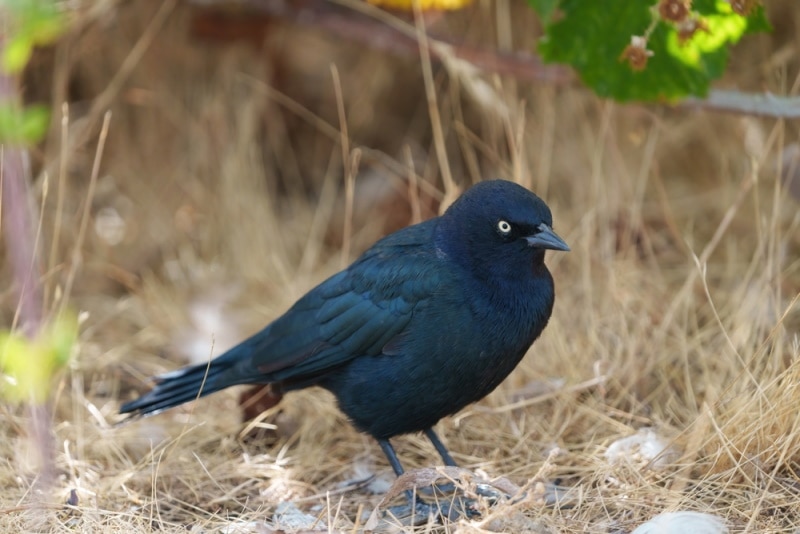
As The Natural State, Arkansas offers a wide variety of plants and wildlife. One of the things you may commonly spot throughout the state is birds that are black. Deceivingly, not all of these are blackbirds.
“Blackbird” doesn’t refer to a specific species or family of birds, necessarily, so there are quite a few birds in Arkansas that could fall into this grouping, including true blackbirds, grackles, bobolinks, and cowbirds. There are also two species of crow that live in Arkansas year-round, and you may spot them and mistake them for blackbirds as well.

The 17 Types of Black Birds in Arkansas
1. Red-Winged Blackbird
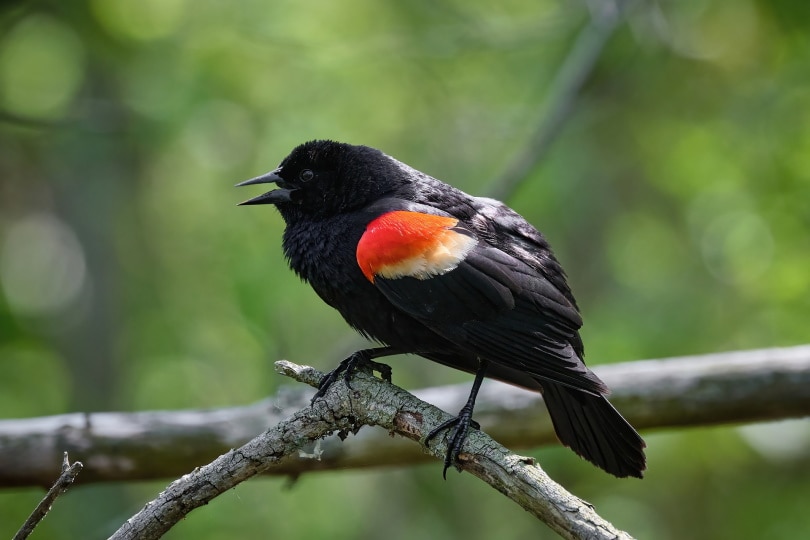
| Size | 6.7–9 inches |
| Diet | Insects, seeds |
The red-winged blackbird is distinctive in its appearance, thanks to the red and yellow feathers that sit on the birds’ shoulders like epaulets. Females are less showy in appearance than the males, but they do still usually have muted forms of the shoulder feathers. Females are typically browner and streaked in appearance. Males are known for their fearless nature, often dive-bombing humans and other animals alike. Females are often aggressive toward other females during the breeding season.
2. Common Grackle
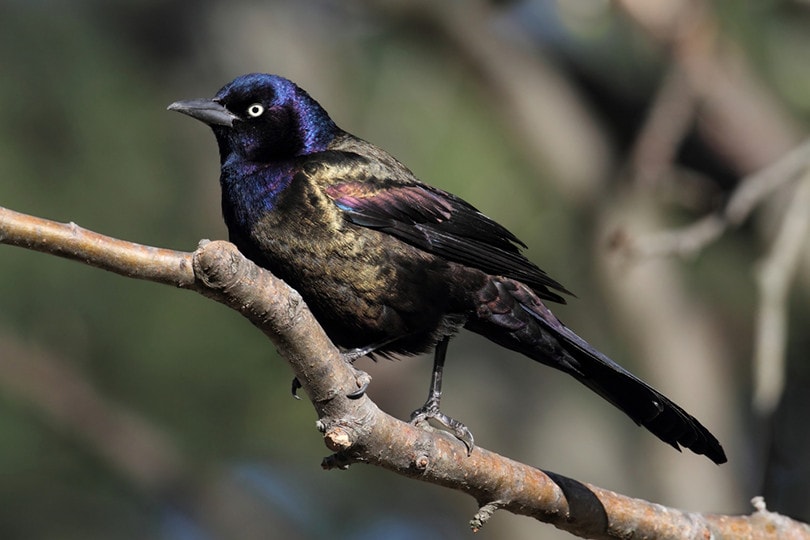
| Size | 11–13 inches |
| Diet | Insects, seeds |
The common grackle is a large bird with long legs and a long bill. They have glossy feathers that often have an iridescence to them, showing bright colors of purple, indigo, blue, and bronze. Females and males look very similar to each other. They tend to travel in flocks, and sometimes can be spotted in huge flocks. They are often quite noisy birds, especially the males. These are generally social and agreeable birds that are more peaceful toward each other and other birds than many other large bird species.
3. European Starling
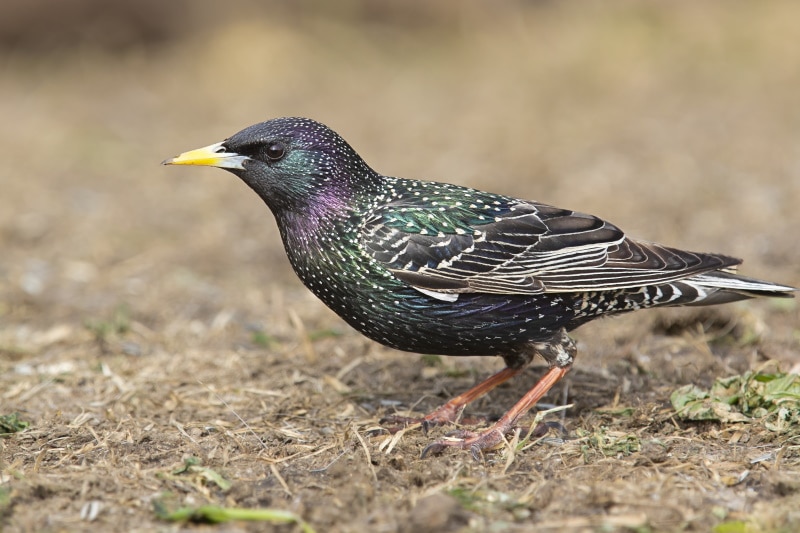
| Size | 8–9 inches |
| Diet | Insects, berries |
The European starling is a non-native species to North America, but it has become one of the most numerous birds on the continent. These birds have short tails and a robust body build. Their name comes from their short, pointed wings, which give them the appearance of a four-pointed star during flight. They often travel in large flocks, and these birds are known for their bullying temperament. They regularly chase off other birds, and it’s not uncommon for a flock of European starlings to take over your bird feeder until it’s empty.
4. Orchard Oriole
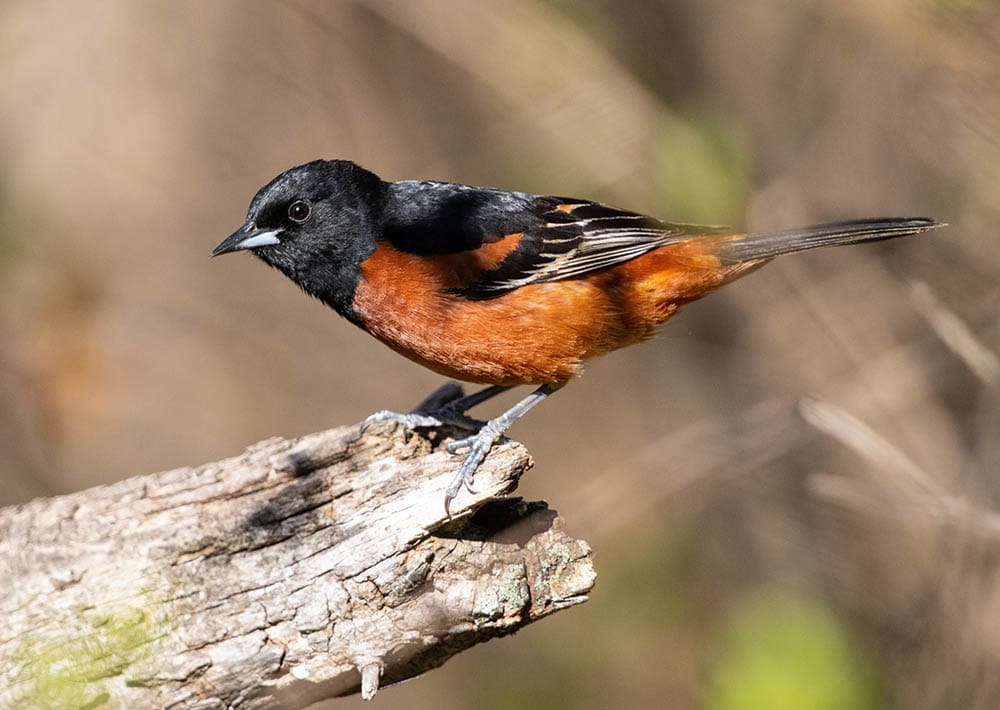
| Size | 6–7 inches |
| Diet | Insects, nectar |
The orchard oriole is an important part of the ecosystem in Arkansas because they function as pollinators. These birds often eat nectar and pollen, especially during the winter months, so they easily spread pollen between plants. These are not solid black-colored birds. Instead, the males have a black throat and head with reddish-brown coloration on the breast and abdomen, while the females are a chartreuse color with white wing bars. These are easygoing birds that are generally agreeable with a variety of other bird species.
5. Baltimore Oriole

| Size | 6.5–8 inches |
| Diet | Fruit, nectar |
The Baltimore oriole also assists with pollination because of their consumption of fruits and nectar. These interesting birds build sock-like, woven nests that hang from surfaces. Males have a black head and back with a white bar across the wings and bright orange on the breast and abdomen. Females are similar in appearance to the males, but they are duller in their appearance and they have two white wing bars. These migratory birds spend the colder months in Central and South America, but you can often spot them in Arkansas during the warmer breeding season. They are said to have a temper for such small birds, with some saying they have a temper to match their fiery orange coloration.
6. Scott’s Oriole

| Size | 8–9 inches |
| Diet | Insects, nectar |
The Scott’s oriole males have a black head and back with a white wing bar and a bright yellow abdomen and chest. The females are duller in color than the males, and they are more of a gray color than black. These birds are great pollinators, but they are also one of the biggest predators of the Monarch butterfly, especially during the winter when the birds and the butterflies have migrated to Central and South America. They are peaceful toward other birds, though, and are not known to regularly squabble over feeders.
7. Bullock’s Oriole

| Size | 6.5–7.5 inches |
| Diet | Berries, nectar |
Bullock’s oriole has the least amount of black on it out of all the Arkansas orioles. These birds have a small amount of black on the head, neck, and back, but the majority of the body is covered in deep yellow feathers. Females are less brightly colored than the males, but they are primarily yellow as well. These birds spend a lot of time hanging upside-down while probing in crevices and holes in trees in search of insects and nectar. They are fearless birds that are known to mob other animals that they see as a threat to their nesting sites.
8. Brown-Headed Cowbird
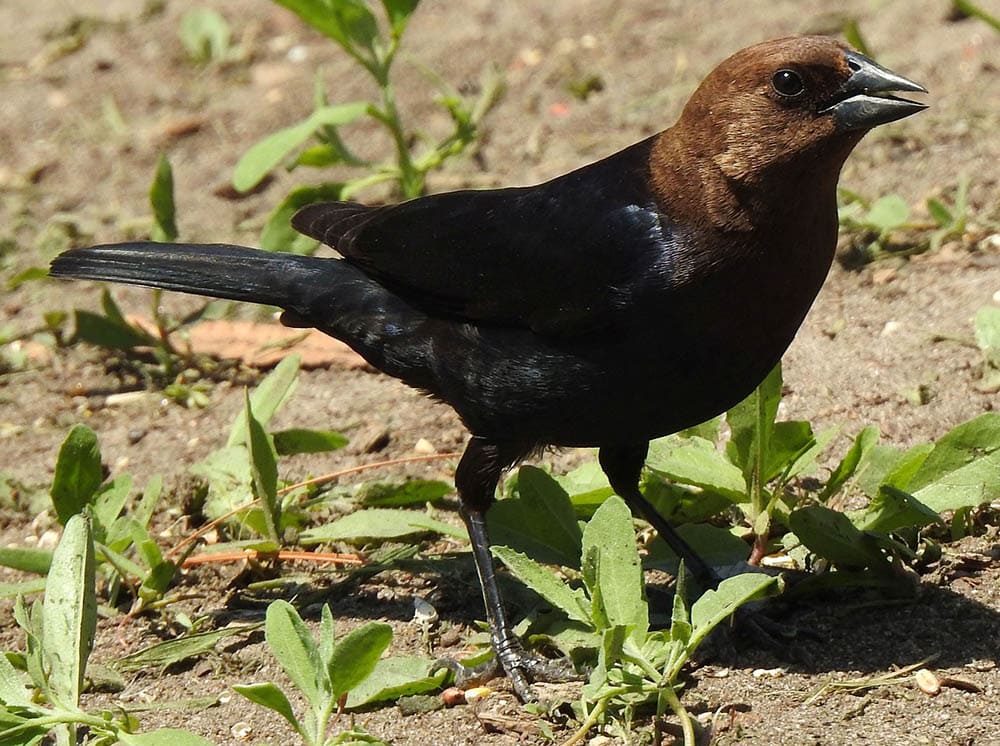
| Size | 6.5–8 inches |
| Diet | Seeds, insects |
The brown-headed cowbird is an interesting bird for their tendency to practice brood parasitism. This means that they lay their eggs in the nests of other birds, and then the other bird will hatch and raise their young. Brown-headed cowbird chicks often outcompete other chicks for food, and some may even kick the nestmates out of the nest. However, studies have shown that brown-headed cowbirds may retaliate if their parasitic eggs are destroyed, sometimes resulting in them destroying the nest and other eggs. The females are brown, while males have glossy black feathers except on the head, which is brown.
9. Bobolink

| Size | 6–7 inches |
| Diet | Insects, grains |
The bobolink is also known as the “rice bird,” due to this species’ tendency to consume rice from rice fields. They have been known to decimate rice fields, and for this reason, some people consider them pests. These birds have a short neck, tail, and beak. The males have a black body with white on the back and a white wing bar and tan on the back of the head. Females are mottled brown in appearance. Interestingly, males look very similar to females after they’ve molted post breeding season, and they remain this way until spring.
10. Western Meadowlark
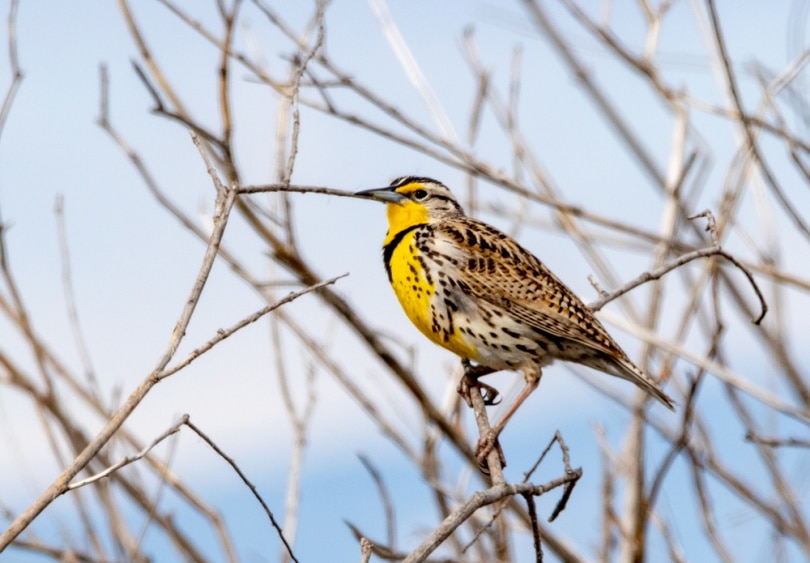
| Size | 6.5–10 inches |
| Diet | Insects, seeds |
The Western meadowlark is far from a solid black bird. Instead, the males have a delicate balance of black, brown, and buff coloration on the back, wings, neck, and head, while the chest and abdomen are yellow with a black necklace. In the winter, these birds are primarily gray and much duller in appearance. They can often be spotted on the ground probing the ground for insects and seeds to eat. Males will arrive at their breeding grounds a few weeks before the females, giving the males time to build and defend their territory.
11. Great-Tailed Grackle

| Size | 15–18 inches |
| Diet | Small animals, seeds |
The great-tailed grackle is interesting for its widely varied diet. These birds are true omnivores, and they will eat everything from the hatchlings of other birds to small fish, lizards, seeds, grains, and fruit. Males have iridescent black feathers all over, while females have multiple shades of brown on them. They have long, full tails that make them stand out from other similar looking blackbirds. They often gather in extremely large flocks, sometimes with as many as tens of thousands of birds in a single flock. They are highly social birds that often forage for food peacefully in the presence of other bird species.
12. Eastern Meadowlark
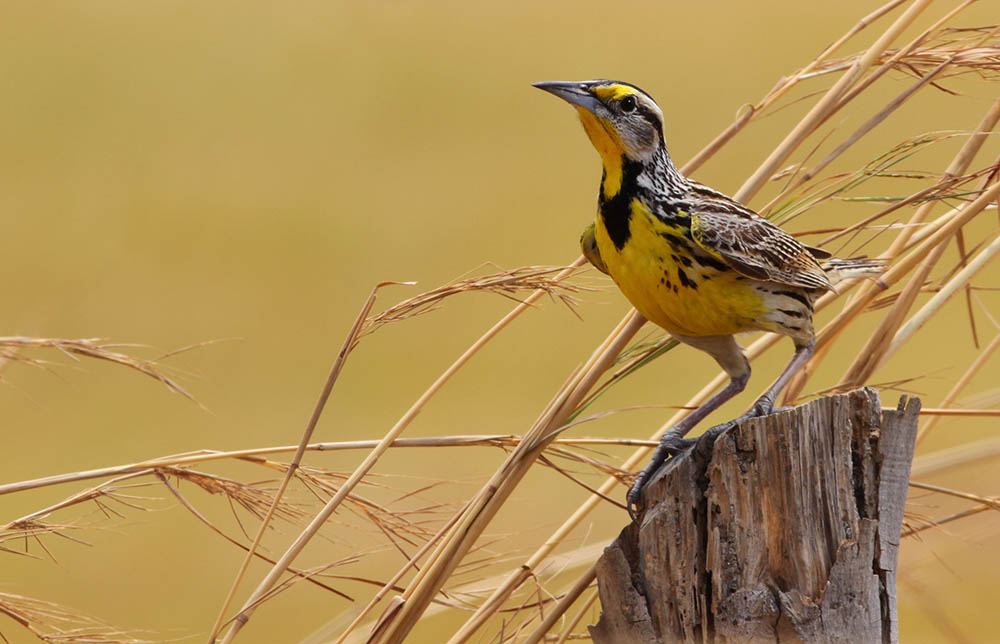
| Size | 7.5–10 inches |
| Diet | Insects, grains |
The Eastern meadowlark are extremely similar in appearance to the Western meadowlark, although it’s rare for these two closely related birds to hybridize. There are very minor differences in the color layout on both birds, but the easiest way to tell them apart is through their calls. The Eastern meadowlark spends a lot of time on the ground in search of insects and other food. Like the Western meadowlark, the males arrive a few weeks ahead of the females to the breeding grounds to prepare a safe and guarded territory.
13. Rusty Blackbird
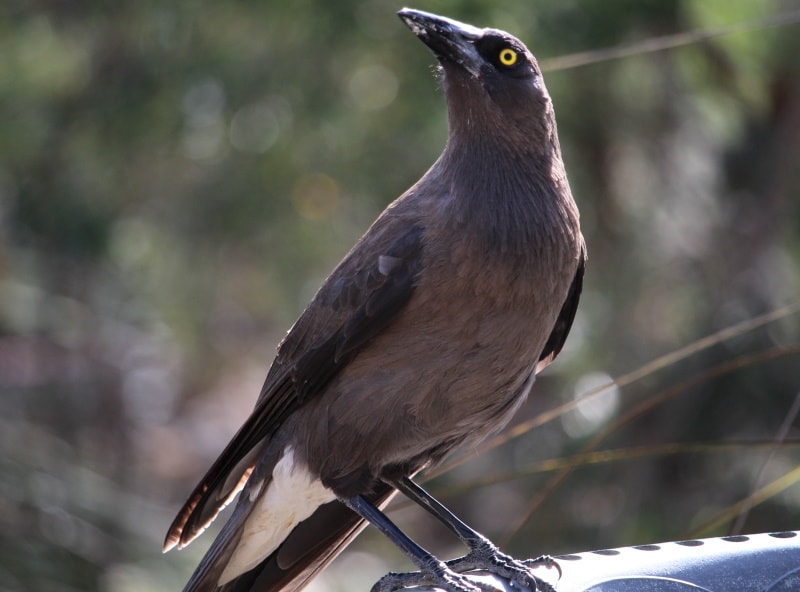
| Size | 8.5–10 inches |
| Diet | Insects, small animals |
The rusty blackbird has black feathers with rust-colored tips on them, giving them their name. They also have prominent “eyebrow” feathers that are usually brown in color. They’re known to eat a variety of things, including amphibians, insects, grains, and fruit. They often spend time in large flocks, sometimes joining with other species of bird. Large, mixed flocks of rusty blackbirds and other blackbirds even occur in urban areas. These are generally agreeable birds that get along well with others, even in feeding spaces.
14. Brewer’s Blackbird
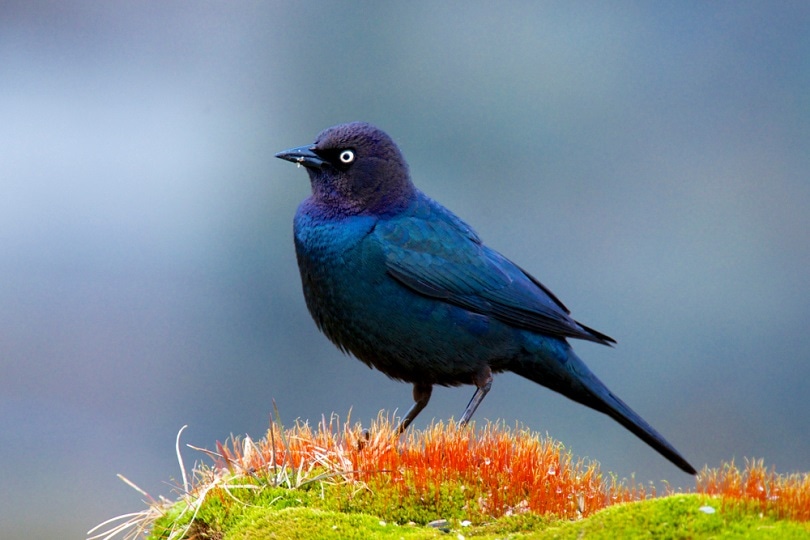
| Size | 8–10.5 inches |
| Diet | Insects, seeds |
The Brewer’s blackbird is a medium blackbird species that has a plump body and round head. The males have glossy black feathers with an iridescent sheen, with purple iridescence on the head and green iridescence on the body. The females are gray with some black on the wings. They often spend time in flocks outside of the breeding season, and mixed flocks of Brewer’s blackbirds and other blackbird species often occur in the winter. These birds are intelligent and are known to follow farm equipment, picking up leftover grains.
15. Yellow-Headed Blackbird
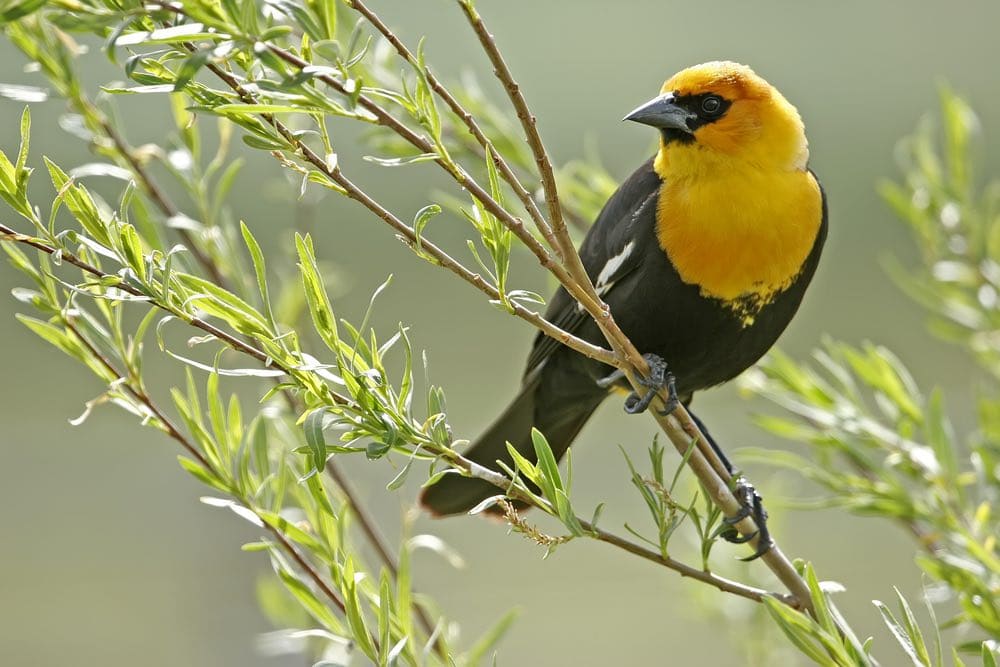
| Size | 8–10 inches |
| Diet | Insects, seeds |
The yellow-headed blackbird has a black body and black wings with a patch of white. They have a brilliant yellow head with black around the eyes. If you can’t spot them, you can at least hear their call, which is described as sounding like a rusty gate. During the breeding season, each male sets himself up with a territory and then attempts to woo as many females to his territory for breeding as possible. Unlike many male birds, the male yellow-headed blackbird will help feed his offspring, but this is usually exclusive to the first nest in his territory.
16. American Crow
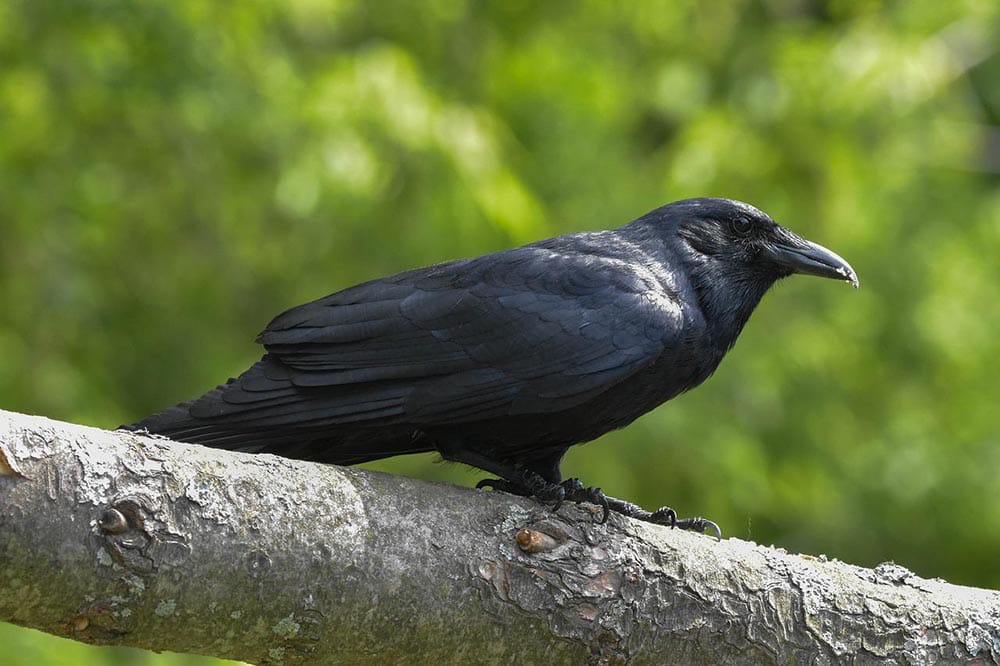
| Size | 16–21 inches |
| Diet | Small animals, berries |
The American crow is a large bird that will consume just about anything, including food scraps, small animals, the hatchlings of other birds, and eggs. They are highly intelligent and social birds typically spotted in family groups consisting of the breeding male and female, as well as the offspring they’ve produced in the last two years. These family groups function cooperatively to find food and maintain a safe territory. Their intelligence and social nature make them highly successful birds in urban and suburban areas.
17. Fish Crow

| Size | 14–16 inches |
| Diet | Insects, eggs |
The fish crow is almost identical in appearance to the American crow, but they are smaller. They are nest robbers that frequently rob the nests of other birds, as well as turtles and other egg layers. They’re also known to steal food from other birds, often after spending time harassing them. They are social birds that form close-knit groups, and mated pairs are often spotted preening each other’s feathers. They spend a lot of time near water, but are not true water birds.

Final Thoughts
The American crow and fish crow are the only birds on this list that wouldn’t be considered blackbirds, but they are solid black birds that can easily be mistaken for some of the other birds on the list. Even though some of these birds may look similar, they are all unique in their own right. It’s essential to understand the importance of different birds in the ecosystem to help us better manage and care for the environment.
Featured Image Credit: 2009fotofriends, Shutterstock
Table of Contents
- The 17 Types of Black Birds in Arkansas
- 1. Red-Winged Blackbird
- 2. Common Grackle
- 3. European Starling
- 4. Orchard Oriole
- 5. Baltimore Oriole
- 6. Scott’s Oriole
- 7. Bullock’s Oriole
- 8. Brown-Headed Cowbird
- 9. Bobolink
- 10. Western Meadowlark
- 11. Great-Tailed Grackle
- 12. Eastern Meadowlark
- 13. Rusty Blackbird
- 14. Brewer’s Blackbird
- 15. Yellow-Headed Blackbird
- 16. American Crow
- 17. Fish Crow
- Final Thoughts
About the Author Brooke Billingsley
Brooke Billingsley spent nine years as a veterinary assistant before becoming a human nurse in 2013, but she still loves all animals! She currently shares a home with three dogs, two cats, five fish, and two snails. She has a soft spot for special needs animals and has a three-legged senior dog and an internet-famous cat with acromegaly and cerebellar hypoplasia. Brooke hosts a podcast focusing on folklore and myth and loves spending her free time researching and writing. Brooke believes that every day is an opportunity for learning and growth and she spends time daily working toward new skills and knowledge.
Related Articles:
Monocular vs Telescope: Differences Explained (With Pictures)
10 Types of Hummingbirds in Arkansas (With Pictures)
8 Types of Hummingbirds in Nebraska (With Pictures)
5 Types of Hummingbirds in Idaho (With Pictures)
3 Types of Hummingbirds in Mississippi (With Pictures)
8 Types of Hummingbirds in Kansas (With Pictures)
5 Types of Hummingbirds in West Virginia (With Pictures)
5 Types of Hummingbirds in Ohio (With Pictures)
